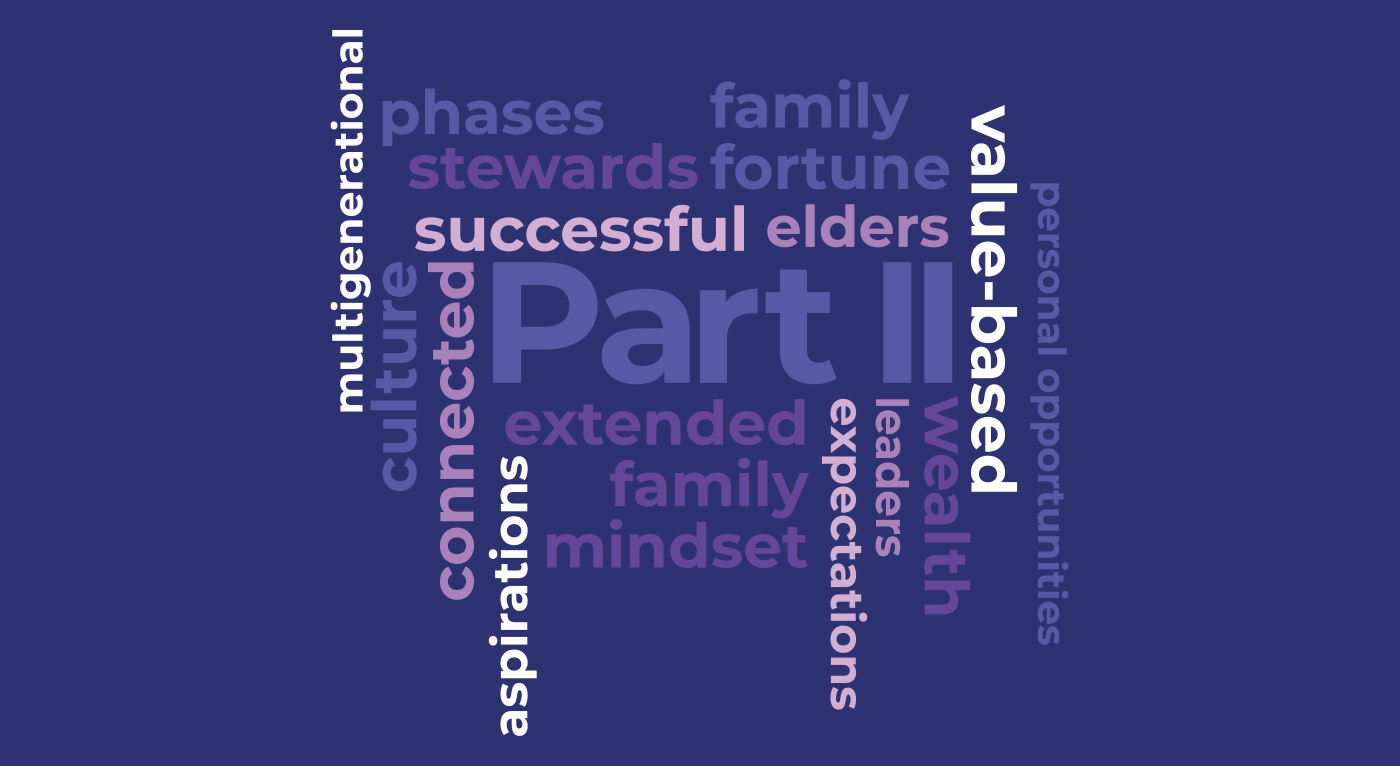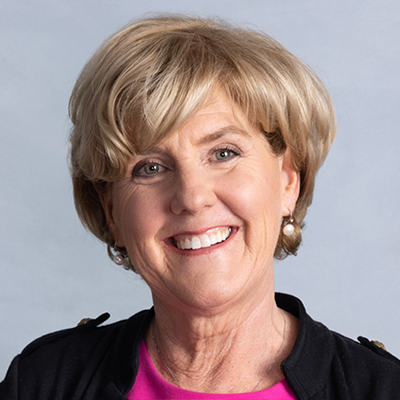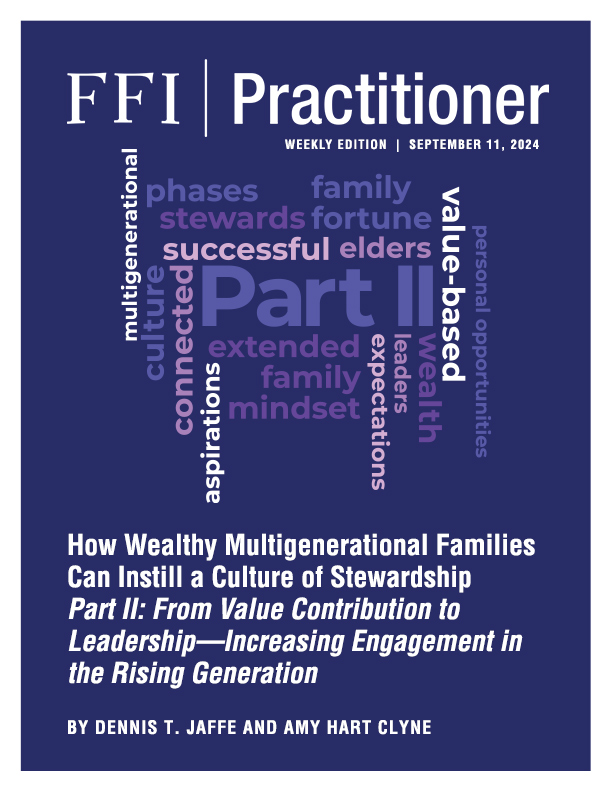Part II: From Value Contribution to Leadership—Increasing Engagement in the Rising Generation

Go here to read or reread Part I, and read on for Part II.
Encourage Value Contribution and Increased Engagement
A culture is created continuously. In other words, a family culture is not “declared” or created in a one-time event. It is formed by the daily actions of family members who affirm and support the family culture. Consequently, after new members have been named as stewards, the family expects them to take on roles in the family governance or other important family activities. The elders should not expect, however, that initiation as a steward will automatically lead to steward-like behavior. New members who become stewards of the family culture must be actively engaged and shown ways to make the family values come alive.
For this to happen, new members need to know what roles are available, what they require, the activities and tasks involved, and the process for taking them on. (Often these roles are part-time.) This knowledge is how the rising generation learns and shows itself ready for greater family responsibility. Even if they work outside the family enterprise, only work part-time within the family enterprise, or are raising a family, new stewards need to become involved. Moreover, if the family expects stewardship behavior, the family members themselves must exhibit these behaviors through personal interactions as well as through what they teach and ask.
Examples for Creating Increased Engagement
Almost any business family, even a small two-generation one, can create roles to add value to the family culture. Typically, there are appointed roles and voluntary roles.
Appointed roles may include becoming a board observer, serving on committees that do the business work of the family, e.g., the family foundation, the family council, or the family office. In these roles, young family members demonstrate interest and capability as future leaders, sharing ideas and working across generations. Although professional and fiduciary boards often require specific experience, they also can offer eligible new members paths to gain experience.
To facilitate engagement, some families appoint a Family Learning Committee to organize engagement efforts. The chair of this group, often called the Family Learning Officer, is a resource for family members who want to become involved in family governance. The Family Learning Office or Family Learning Committee can define potential roles and their availability. Family members learning of these options can state specific interests. Then the Family Learning Committee can collaborate with them to assess when they are sufficiently prepared for certain roles and ensure that their candidacy is known by those who would select members.
The Family Learning Committee may create a “ladder of service,” defining the path from interest to leadership. This path contains many options on the path forward. Too often families only consider the first and last steps, leaving younger family members confused as to how they can prepare to serve. This committee makes that path transparent and encourages family members to lean into these opportunities.
Reset Leadership Roles for Rising Generation and Elders: Next Steps
The above activities allow the family to evolve with young family members learning and demonstrating their capacity for leadership. The next steps facilitate the gradual shift of responsibilities and authority to the rising generation. The family must specify a correct time for the rising generation to enter each leadership role. For that time to arrive, a parallel process must occur in which the elder generation steps away from those leadership roles.
The mistake of some families is acting as if the older generation’s term of office is forever or until they decide to step down. This means that the rising generation must wait with no clear sense of how or when they can become leaders. Such uncertainty can be deflating, even toxic. Jaffe and Clyne suggest that board membership and leadership positions contain term limits. Or there might also be a set retirement age. Setting specific terms of office enables young people who have already demonstrated skills and capability to step into leadership roles and set an agenda for the future. Although an elder can give up a voting role and still attend board meetings as an emeritus member, at some point it is more relevant to discover what the rising generation wants to see rather than ask what the older generation thinks is best.
In this model, two parallel processes allow stewardship and leadership to evolve within the family culture. The first process involves appointing a new generation of leaders and the second defines mentor roles for elders. Both processes are necessary, and they are co-dependent. The shift in leadership is often gradual as roles change at different times. There is often a long period where the two generations share leadership.
Suggestions for Implementation
Jaffe and Clyne’s suggestions for implementing the two processes are as follows.
Appoint a New Generation of Leaders
Each generation needs a new vision of the family enterprise that inspires the rising generation to engage. For this to happen, the family needs to look outward and envision its future in a way that builds upon its legacy and values—not just looking inward to recreate the past. The family must ensure that new leaders are selected with the future vision in mind. Then, as new leaders emerge and begin to have their voices and visions heard, both the older and younger generations can create an alliance that supports the legacy and builds on new ideas. As these rising leaders gain experience and mature, they develop innovations that allow the family and its businesses to evolve. This is family entrepreneurship, a source of vitality in family enterprises.
Despite the promises of evolution and entrepreneurship, there can be problems. For example, there can be a disconnect between the time when the younger generation is ready to assume leadership roles and the time when the elders are ready to step down. Today, elders live and work for many more years than previous generations, so when is the right time for them to move aside to make room for new leadership? The model proposed here is that the family does not prepare for succession at some mythical future time but engages in an ongoing dialogue across generations to balance the legacy with new projects and ideas. The elders have formal control, while the rising generation holds the key to realizing a new vision.
Define Mentor Roles for Elders
The path to stewardship is long, with many exciting phases and stages over a lifetime, culminating with the role of the elder. Nonetheless, a common obstacle to successful multigenerational wealth transfer is an elder who is slow, avoidant, or resistant to pass the reins. Stewardship can be strangled by this inertia and inaction and frequently results in a lack of motivation on the part of rising leaders.
With multiple generations living concurrently, it is critical that a family defines how its elders can stay engaged and contribute to the longevity of the family legacy without stifling the energy of their offspring. Being a mentor is an often-overlooked solution. This frequently missed step should be initiated and be supported by trusted, long-term family advisors. Their understanding of the family and its systems gives them a keen sense of how the elders can make room for and support new leaders, while at the same time gaining a sense of purpose and identifying new paths forward for themselves. Across the family spectrum, the journey that instills this kind of stewardship mindset allows family members to have the best of both scenarios—strong family connections and an honoring of individual passions and pursuits.
Concluding Thoughts
Families that are concerned with how their children and grandchildren will use their inherited wealth and lead the family enterprise should take active steps to allow the family culture to change from the time when their children are young. Culture change involves much more than teaching financial literacy. The rising generation must commit to learn and enter their roles as stewards in the family, while elders need to welcome new leadership and ideas and accept new roles for themselves.
The generational shift in leadership means much more than naming new members to enter old roles. Family enterprises are continually changing, and the enterprises that the new generation inherits and leads are quite different from those of the past. This means new generations must bring new skills and fresh mindsets to the family in the efforts to support and strengthen the family culture.






